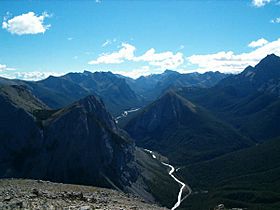Fiddle River facts for kids
Quick facts for kids Fiddle River |
|
|---|---|

The Fiddle River in Jasper National Park
|
|
| Country | Canada |
| Province | Alberta |
| Physical characteristics | |
| Main source | Fiddle Pass 2,058 m (6,752 ft) 53°01′47″N 117°30′44″W / 53.02972°N 117.51222°W |
| River mouth | Athabasca River 997 m (3,271 ft) 53°13′52.1″N 117°51′33.1″W / 53.231139°N 117.859194°W |
The Fiddle River is a cool river located in Alberta, Canada. It is a medium-sized tributary of the Athabasca River. A tributary is a smaller river or stream that flows into a larger one. The Fiddle River joins the Athabasca River near the east entrance of Jasper National Park.
This river begins high up at Fiddle Pass. Its water comes from melting snow and ice on mountains like Mount Bryant, Mount Gregg, Mount Sir Harold Mitchel, and Mount Barry. The Fiddle River flows mostly towards the northeast. Eventually, it meets the Athabasca River. Part of the Fiddle River runs alongside the road that leads to the popular Miette Hotsprings.
Contents
Why is it called Fiddle River?
There are two interesting stories about how the Fiddle River got its name. This name also applies to Fiddle Peak, Fiddle Pass, and the Fiddle Range. The name Fiddle River was first used in 1846.
The Musical Wind Story
One idea is that the wind blowing over the Fiddle Range can sound like a fiddle string. If the wind blows at just the right speed and direction, it might make a musical sound.
The Violin Shape Story
The second story suggests that the outline of the Fiddle Range looks like a violin. A violin is a musical instrument, also known as a fiddle.
What Rivers Flow into the Fiddle River?
Many smaller streams and creeks flow into the Fiddle River. These are its tributaries. They add water to the Fiddle River as it makes its way to the Athabasca River.
- Poachers Creek
- Slide Creek
- Sulphur Creek
- O'Hagan Creek
- Mystery Creek
- Villeneuve Creek
- Morris Creek
- Ashlar Creek

